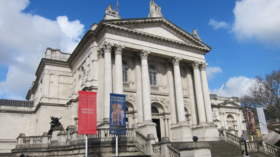Tate scrapes bottom of barrel in its drive for diversity, accepts TAMPONS as art

London’s Tate, apparently in its drive for diversity, has accepted a corporate donation of art that includes tampons. It discredits the gallery as a body which is supposed to preserve the best contemporary art for the nation.
Bolton Quinn agency announced in a press release on October 14 that the Tate had accepted new art pieces by five artists, including a work by Vietnamese-born artist Sung Tieu entitled “Filling Gaps.” It’s described as “Tampons from VEB Vliestextilien Lößnitztal, polished stainless-steel tube with framed Work Contract, stamp on digital print, framed, 25 x 1200 x 25 mm”. Although the press release does not tell us, we can presume the tampons are unused. Menstruation has been the subject of feminist art since the 1960s.
More baffling is a collection of “natural stones and fruit,” entitled The Echo of an Ancient Form of Knowledge. This “art work” is by Edgar Calel from Guatemala. The most incomprehensible part of the acquisition is the accompanying note that states, “Tate has agreed with the artist, Edgar Calel, to become the custodian of Ru k’ ox k’ob’el jun ojer etemab’el, (The Echo of an Ancient Form of Knowledge). Through entering into this alternative to a conventional acquisition, the museum welcomes an opportunity to listen to and learn from the knowledge that the work (and, more broadly, Maya Kaqchikel cosmology) holds.” That sounds like a contract that will never be honoured. Indeed, who knows what it entails?
Congratulations Edgar Calel ! @TateWill be the custodian of Ru k’ ox k’ob’el jun ojer etemab’el (The Echo of an Ancient Form of Knowledge), 2021. Edgar Calel was part of @Tropicalpapers residency program in 2021 #edgarcalel@ProyectosUvpic.twitter.com/GnXhgrLtq1
— Tropical papers (@Tropicalpapers) October 16, 2021
The artworks were purchased for Tate by Endeavour from the Frieze Art Fair, London. Endeavour is described as “a global entertainment, sports and content company comprised of industry-leading brands including WME, IMG and UFC”. According to the press release, the acquisitions cost £150,000 (US$207,000).
The purchase selection panel included Polly Staple, one of the directors of Tate. Her definitions of art may differ from yours. For instance, one of the events she arranged at her previous job as director of London’s Chisenhale Gallery in 2016 was to... close the gallery as a 5-week conceptual art stunt. She and the contracted staff got paid (in part by the Arts Council of England funds) while the venue was closed to the public. Staple became Director of Collections at Tate in January 2020.
Also on rt.com Creating a ‘Brave New World’: Rather than guarding Britain’s national treasures, woke museum curators want to dispose of themSubstandard art, unwritten quotas
One of the reasons these acquired art works are so shoddy is that current-day Tate does not so much buy art as artists. Tate appears to be engaged in a massive drive to acquire contemporary art, primarily on the basis of the ethnicity, religion, sex and sexual orientation of makers. The aim is to make the collection more “diverse.”
In 2017, Tate wrote to me and stated its aim was “to generate a rich mix which moves towards a fairer gender balance.” In a post-modern era, aesthetic qualities are subjective, so anything can be defined as art, which allows curators to acquire substandard art because they want to boost demographic “representation” in the collection. That same year, I published an essay in The Jackdaw, which was later re-published in expanded form in the book Culture War. In it, I had five predictions for Tate. This is number 1:
“Collection and exhibition of art will be increasingly driven by the imperative to promote female/minority artists regardless of aesthetic or formal qualities of their art. There will be a drive to pack the collection with art by women/minorities in an attempt to reach arbitrary statistical targets. The contemporary collection will become a massive ever-inflating multi-million-pound experiment in social engineering grounded on untested principles, driven by ideology and set to utilitarian goals: to demonstrate virtue and make visitors virtuous.”
When I approached the Tate this year on their policy regarding “diversity,” a representative replied: “Without imposing targets or quotas, Tate believes firmly in representing different viewpoints and backgrounds in all that it is. We do this through various means, from increasing representation through a diverse collection strategy, to advertising roles to reach as diverse a candidate pool as possible.”
Also on rt.com Left-wing social justice collectives have captured Britain’s premier art prize. This ‘artivism’ is destroying the museums we loveThis admission shows that diversity is an aim but – for legal and political reasons – Tate does not have a written policy on this matter. This allows Tate to apply unspoken informal quotas rather than written formal quotas. The results are the same, but it means that, should any legal case arise, culpability for discrimination is difficult to pin on Tate’s management.
The absurd material acquired by national museums across the West is partly explicable as a politically-correct drive to defeat so-called marginalisation by buying in bulk art by women and minorities. If you question the quality of the art, you are a “boor.” If you question the ethics of the policy, you are a “bigot.” Get used to it. There is more coming.
Like this story? Share it with a friend!
The statements, views and opinions expressed in this column are solely those of the author and do not necessarily represent those of RT.














